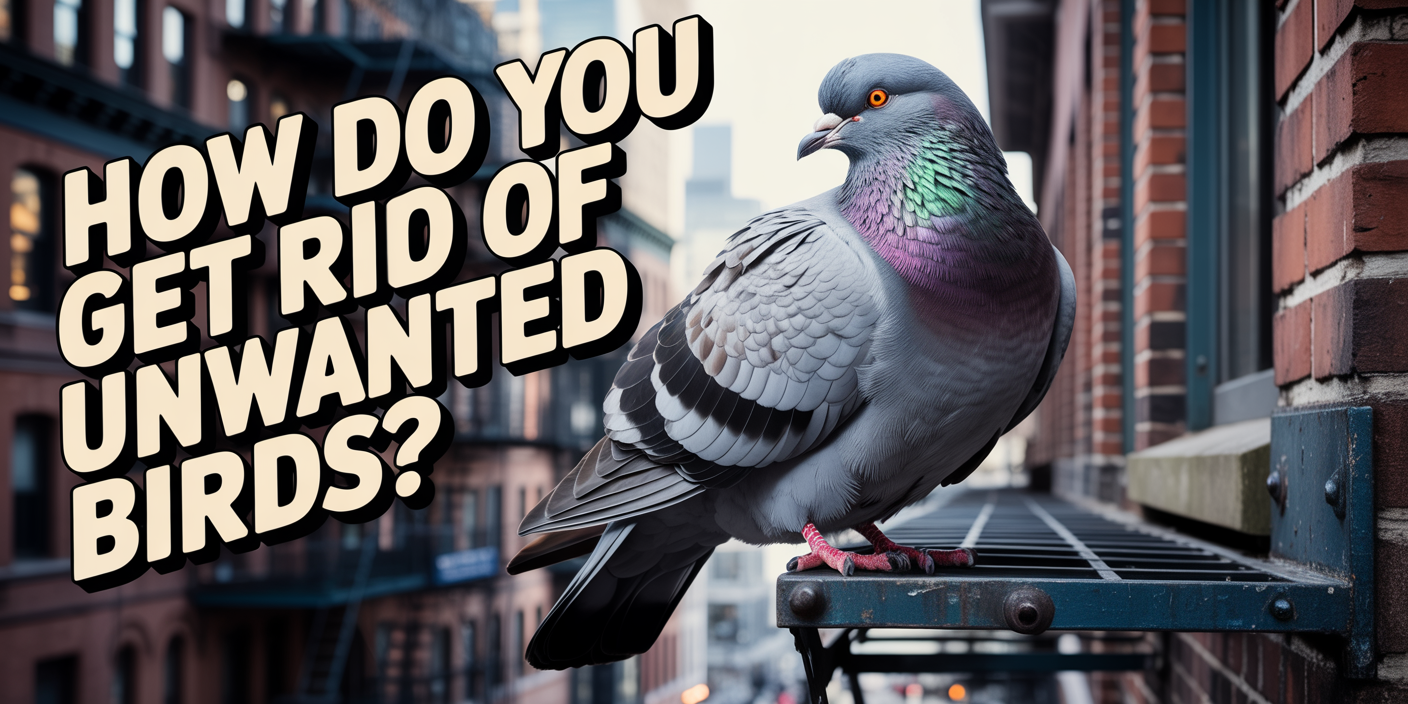“The best way to get rid of unwanted birds is through humane exclusion and long-term prevention. Seal entry points, remove attractants, and use bird deterrents that discourage them from nesting or returning.”
Florida’s Treasure Coast is paradise for sun-seekers, and for birds that treat your roof as beachfront real estate. Pigeons cluster in noisy flocks on Spanish tiles, woodpeckers drum holes into trim, and grackles turn gutters into twiggy condos. Warm breezes, endless snacks, and abundant nesting nooks make every attic vent or solar panel an irresistible invitation.
Corrosive droppings, blocked vents, and nonstop pecking quickly follow, raising health risks and repair bills faster than pelicans scoop fish. AAAC Wildlife Removal of Treasure Coast steps in with humane, fully legal bird control strategies that send these feathered freeloaders packing and keep them from circling back. Our local team understands the nesting habits, migration patterns, and regulations that shape a safe, effective bird-proofing plan.
Learn more: Who can remove a bird from my house?
Why Are Birds Nesting Around My Home?
Your home might feel like a five-star bird hotel without you even realizing it. Birds are always on the lookout for safe, quiet places to nest—and Treasure Coast homes check all the boxes. Vents, chimneys, roof eaves, solar panels, and even covered patios offer ideal shelter, making it hard to prevent birds from landing and settling in.
The warm, humid climate adds to the problem by providing a steady supply of food year-round. Fruit trees, pet food, bird feeders, and even crumbs from outdoor meals all create irresistible feeding grounds. Once one bird takes up residence, more follow and quickly form noisy, destructive colonies that are hard to remove.
Trying to scare birds away might offer a temporary fix, but unless you block access and remove the attractants, they’ll come right back. A truly effective method involves a mix of habitat changes, deterrents, and sealing up potential nesting spots—all designed to keep your space bird-free for good.
Safe and Legal Bird Removal in the Treasure Coast
Bird Protection Laws You Need to Know
The quickest way to get rid of birds often collides with federal and state regulations, so every plan has to start with the legal basics. The Migratory Bird Treaty Act and Florida wildlife rules protect many species, their nests, and even their favorite roost spots. Ignoring these laws invites hefty fines and headaches, making a clear, compliant strategy essential from day one.
Humane Exclusion Beats Harmful Tactics
AAAC Wildlife Removal of Treasure Coast relies on proven bird deterrent methods—one-way exit doors, sturdy netting, and habitat tweaks—that discourage birds from roosting without causing harm. By allowing fledglings to leave safely before sealing entry points, we keep pest birds out while protecting local wildlife. The result is a humane, long-term fix that safeguards your home and the ecosystem.
Professional Help Ensures Compliance and Results
Licensed technicians understand local bird behavior, identify protected species on sight, and craft site-specific strategies to permanently get rid of birds. They clean, sanitize, and seal all access points so flocks can’t establish a new roost, leaving you with a quiet, healthy, bird-free property for the long haul.
Proven Methods to Deter Birds in the Treasure Coast
- Block Entry Points with Bird Netting– Bird netting is one of the most effective long-term solutions for keeping birds out of attics, vents, garages, and overhangs. It creates a physical barrier birds can’t bypass, and when installed correctly, it blends in visually without damaging your home’s look. This method is especially helpful for persistent pigeons and sparrows that love nesting in rooflines.
- Use Visual Deterrents to Scare Birds Off– Reflective tape, scare balloons, and even decoy predators like owls can spook birds enough to make them rethink your property. These tools work best when used in combination and moved around regularly to keep birds from getting used to them. For Treasure Coast homes near open fields or water, visual deterrents are a great first line of defense.
- Install Ledge Guards and Bird Spikes– Flat surfaces like window sills, signs, and balcony rails are prime perching spots. Adding bird spikes or sloped guards removes the comfort factor without causing harm. They’re particularly effective for commercial buildings and multi-unit properties that deal with recurring pigeon flocks.
- Set Up Sound-Based Deterrents– Ultrasonic or recorded distress call devices can make your property uncomfortable for birds without bothering people. These are ideal for barns, warehouses, or larger open areas, and they’re best used alongside physical deterrents for lasting impact.
- Make the Environment Less Inviting– Trim trees, cover vents, and clean up fallen food, pet dishes, and garbage to remove attractants. Birds are far less likely to stick around if there’s nowhere to land, nothing to eat, and no safe place to nest. A cleaner yard and roofline makes a big difference in long-term prevention.
Can DIY Bird Control Work in Florida?
At first glance, DIY bird control can feel like a fast and easy fix. Hanging shiny objects, spraying homemade repellents, or setting out decoy predators might give the impression that you’re doing something productive. In minor cases, these quick solutions might work temporarily—but they rarely solve the root problem.
The challenge is that birds are smart and adaptable. Most nuisance species, especially those common in the Treasure Coast, will quickly get used to static deterrents or simply shift to another part of the property. Without a full strategy that includes entry point sealing, consistent deterrents, and behavior-based solutions, DIY attempts often lead to frustration and wasted time.
Even more concerning are the risks that come with doing it yourself. Accidentally disturbing protected birds, sealing off an active nest, or using unauthorized repellents could lead to legal consequences. More importantly, ineffective efforts give birds more time to nest, breed, and cause damage. For a lasting solution, professional intervention is the safest route.
How AAAC Wildlife Removal of Treasure Coast Handles Bird Problems
Step 1 – Inspect and Identify
Every bird control job begins with a thorough inspection of your home or building. Our team identifies the species involved, locates entry points, and pinpoints nesting areas. This helps us create a removal plan that’s both legal and tailored to your specific situation.
Step 2 – Safe and Legal Removal
Once we understand the scope of the issue, we use humane, law-compliant exclusion techniques to remove the birds. One-way doors and specialized traps (when permitted) allow birds to exit without re-entering. We avoid disturbing active nests until it’s safe, following all Florida and federal wildlife rules.
Step 3 – Secure and Prevent
After removal, we seal off access points using bird-proof materials like mesh, screens, and flashing. Our goal is to make sure birds can’t return to nest in the same spot again. We customize deterrents to your home’s layout, ensuring they’re both discreet and effective.
Step 4 – Clean and Sanitize
Birds leave behind droppings, feathers, and nesting materials that can carry disease and attract pests. We thoroughly clean and disinfect affected areas to eliminate health risks and odors. A clean, sealed space discourages future bird activity and protects your home for the long haul.
What Types of Birds Cause the Most Problems Here?
- Pigeons– Pigeons are one of the most common nuisance birds on the Treasure Coast. They gather in large flocks, leave behind corrosive droppings, and build nests in hard-to-reach areas like rooflines and HVAC units. Their presence can quickly lead to property damage and hygiene concerns.
- Woodpeckers– These birds might look charming, but their pecking habits can cause serious structural issues. Woodpeckers are known to drill into siding, fascia boards, and even chimneys in search of insects or to create nesting sites. The repetitive noise is also a major annoyance for homeowners.
- Grackles and Starlings– Both species are loud, aggressive, and prone to nesting in tight spaces like dryer vents or soffits. Grackles often arrive in large numbers and make a mess of yards and rooftops. Starlings, meanwhile, can displace native birds and spread quickly across neighborhoods if not addressed.
- Vultures– While less common in residential areas, vultures sometimes gather in groups and cause damage to shingles, pool screens, and vehicles. They’re also federally protected, so handling them improperly can lead to fines. Their size and aggressive behavior can be unsettling for homeowners trying to enjoy outdoor spaces.
Why You Shouldn’t Ignore a Bird Infestation
What starts as a few stray feathers can snowball into a full-blown crisis if you don’t keep birds away early. Nests jam vents, clog gutters, and sit dangerously close to wiring, while constant pecking shreds insulation and roofing—all of which drives repair costs through the roof and spreads bacteria away from your property.
Those droppings aren’t just ugly; their acid chews through paint, metal, and concrete, and the spores can trigger illnesses like histoplasmosis. The longer birds linger, the tougher they are to evict, so calling a professional pest control team now saves major headaches later.
AAAC Wildlife Removal of Treasure Coast swoops in fast with humane tactics that push birds away from your property for good, sanitize the mess, and seal every gap so the flock doesn’t circle back.




